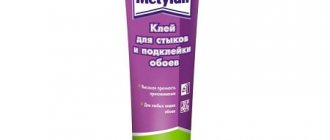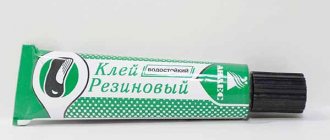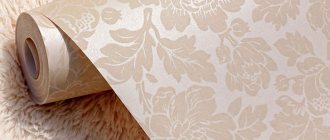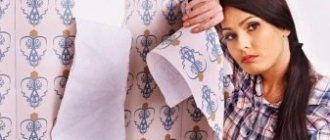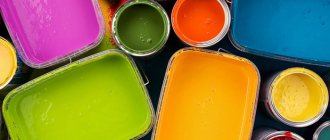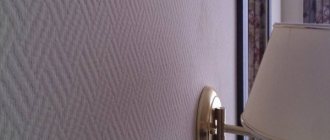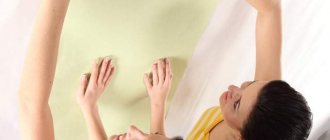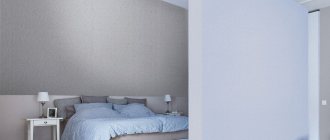Introduction
This coating looks expensive and impressive
Wallpaper is one of the most popular and inexpensive ways to decorate walls in residential areas. There are hundreds of textures, colors, prints and sizes on sale. They allow you to transform a room in a matter of hours, radically change its “appearance”, and create a unique interior in the chosen style.
All wallpapers are divided into two large subgroups: paper and vinyl. We are talking about a substrate on which a decorative layer is applied. It is its quality and physical characteristics that are responsible for the ability of the finishing material to adhere to a vertical surface.
We also advise you to look towards other products, such as photo wallpaper. This type is now in trend and there are a huge number of design solutions on the market.
What is vinyl wallpaper on a non-woven basis?
Matte shine and voluminous texture
First, let's look at the basic concepts that will be discussed.
Vinyl wallpaper is a modern finishing material with a multi-layer structure. It is distinguished by improved quality characteristics and higher cost. There are several types of vinyl wallpaper.
Non-woven fabric is a semi-synthetic substance made from paper-like materials. It is better than paper: much stronger, elastic, non-flammable, moisture-proof, color-fast, and not prone to abrasion. Its main disadvantage is its weight, due to which ordinary universal glue does not cope with its task.
Paper wallpaper is a classic finishing option, known to our grandmothers. They are held on with ordinary paper glue, which is used to treat both the roll and the wall.
The coating is afraid of moisture, is prone to abrasion, can peel off, and fades over time.
Types of vinyl coverings
Foam type
The coating is usually classified according to the following criteria:
- By weight. There are light and heavy
- By type of decorative layer: foamed, dense vinyl
- By type of base. There are specimens on fabric, paper and non-woven bases
Wallpaper on a non-woven backing belongs to the subgroup of heavy examples. Their outer layer can be anything:
- Foamed vinyl demonstrates a relief image and conveys the depth of the image as accurately as possible. The three-dimensional effect allows you to imitate the rough surface of stone, wood, brick, and textile textures
- Thick vinyl has a smooth, glossy sheen. Panoramic paintings and expressive drawings look beautiful on it. They are easy to clean, do not wear out, and last a very long time.
Advantages and disadvantages
Luxury and sophisticated interior thanks to spectacular wall coverings
Advantages:
- They stretch, so if the building shrinks, they do not tear or crack. Also, elastic fabrics are easier to glue
- The glue is applied directly to the wall, which makes gluing easier
- The coating can be washed without harming the decorative layer
- The products are distinguished by high wear resistance
- They contribute to sound insulation
- This finish, due to its density, retains heat perfectly.
- The coating is not affected by UV rays, which means the intensity of the picture will not change after many years
- The average service life of non-woven vinyl wallpaper is 7-10 years
Flaws:
- High price (compared to paper counterparts)
- The heaviness that results in “capriciousness” during the gluing process
- The polymer binder of non-woven fabric contributes to the moisture resistance of the material. Accordingly, the ability to absorb water decreases. This means that adhesive properties decrease
- The need to purchase special glue suitable for a specific product
The ceiling is rarely decorated with this coating. Due to the same weight, wallpaper most often falls before final drying. We can only blame gravity for this.
How to choose the best glue
The denser the canvas, the thicker the substance is diluted
To prevent the wallpaper from falling off the very next day after hanging, buy the right product. All-purpose wallpaper adhesive or a product for vinyl coverings with a paper backing will definitely not work for you .
The substance for the non-woven base is more viscous and thick, since the liquid material does not provide the necessary tenacity.
What to consider when purchasing
It is best to buy goods at a building materials store
- Type of wallpaper. As a rule, textured foam coatings are heavier than smooth ones. They will need glue with better adhesion
- In which room will they be pasted? In the kitchen, hallway and bathrooms, non-embossed wallpaper is usually glued because it is easier to clean. Buy an adhesive composition marked “for washable coatings”
- Humidity . The glue will dry longer in rooms with high performance
- Temperature. In small rooms it is usually higher
- Dust level
To avoid running into a fake, buy glue from reputable suppliers, or better yet, from large building materials stores. Here you can contact a consultant for advice. And also, the assortment is always richer.
Approximate composition of drugs
Methylcellulose
It is the same for all products:
- The basis
- Bactericidal additives against mold
- Glue
- Sometimes indicators (react in color to the density of application)
The most important thing, oddly enough, is not the glue at all, but the base. The adhesive characteristics of the mixture depend on it.
There are two types of base:
1 Modified starch . It is inexpensive, but not always effective for the coating in question. But it is harmless to the respiratory system, easy to wash and quickly diluted
2 Methylcellulose . A product based on this type is expensive, but it promotes excellent adhesion of surfaces. It penetrates deep into both structures, securely fixing them together
Signs of quality glue
There are many types of substance
How to understand that the product will not let you down? Please note the following points:
- Products from well-known brands with many positive reviews are rarely of poor quality
- The packaging comes with clear and accessible instructions, and the process of preparing the substance is not complicated
- During dilution using this technology, the glue does not clump together
- The product has a decent shelf life (unopened)
- The diluted product can be stored for at least several days.
- Ingredients include antiseptic additives
- The box contains safety and environmentally friendly marks.
Average product consumption
Approximate table of product consumption
Usually the approximate consumption of finished raw materials is indicated on the box or in the instructions. The number of rolls or surface area is indicated. Most often, one standard box is enough to glue 4-5 rolls or 25 m² of surface.
In some cases, finishing professionals recommend adding a little of this glue to the primer used to prepare the walls. In this case, more substance will be needed.
Prices depend on the manufacturer and the amount of mixture in the package. On average, you will have to pay from 100 to 200 rubles per box, and the amount of product varies from 150 to 500 g of dry powder. For comparison, universal wallpaper glue costs about 50 rubles. for half a kilo of product.
Which adhesive is best to buy for vinyl wallpaper?
On the packaging of special glue it is always written what kind of wallpaper it is intended for - heavy or light. It is also worth considering the conditions for further use of the finish. If the temperature and humidity in the room being glued is high, then the glue must be moisture resistant.
For unheated rooms, compositions with an extended operating temperature range are chosen. In both cases, antifungal components will be useful, since vinyl “does not breathe” and can develop black spots.
A composition that is too cheap is likely to be of poor quality - a “golden mean” is needed. Vinyl adhesives are seriously different from conventional and universal products, and they cannot be cheap. It is desirable that the mixture also contains an indicator pigment. This will allow you to check that the glue is applied correctly to the canvas and avoid bubbles under the remaining dry areas.
When calculating the required amount of glue, approximately 10% should be added as a reserve in case of overuse.
Recommendations: 13 Best Glue Guns
15 Best Tile Adhesives
Best wallpapers
Top 7 best brands
| Name | Description |
| French brand Kleo | The product line includes many adhesive products for different types of coatings. For vinyl wallpaper there is a universal adhesive with modified starch as a base. |
| German brand Pufas | Offers a product based on methylcellulose, which is suitable for the densest and heaviest wallpaper. It mixes perfectly smoothly, quickly turning into a homogeneous mass without lumps. Hypoallergenic |
| Another “German” Metilan | Starch based. The composition also contains an indicator, which turns pink when in contact with the surface. This allows you to apply the substance evenly without gaps. |
| French product "Quelyd special vinyl" | Recommended for rooms with high humidity levels for gluing heavy-weight canvases. Judging by this characteristic, it is suitable in the most difficult situations. Costs more than its analogues |
| "Moment" | A well-known German drug that includes both methylcellulose and modified starch. Of the above five, it is the most optimal in terms of price-quality ratio |
| Domestic glue “Quality” | Modified potato starch costs only 75 rubles for 300 grams of powder. It dilutes well, without forming lumps |
| English brand "Exclusive Axton" | Offers an excellent product based on the same starch, which users call the most economical for its low consumption. True, the heaviest canvases should be glued to another product |
Step-by-step instructions for working with glue
Pasting is a painstaking process
Carefully read all the recommendations in the instructions for the box.
How to breed
The powder is poured into cool water in a thin stream.
- Check the expiration date
- Prepare an enamel container
- Dilute the raw materials with cool water at a temperature of 25-30°
- Pour the powder in a thin stream, while stirring the substance
- Stir the mixture thoroughly so that there are no lumps or clots
- Allow the mixture to sit for 10 minutes and stir again
How to apply
Use a soft brush to spread the substance over the wall.
When working with this coating, the adhesive mass is applied directly to the wall. The surface must be prepared and cleaned of old finishing materials. Using a pencil and a level, mark the wall so that future canvases lie flat, the upper edges strictly horizontal to the baseboard.
The mixture is distributed along the wall with a soft brush from top to bottom along the perimeter of the strip. Apply the cloth and gently smooth it from the ceiling to the floor with vertical movements. Wipe off excess glue with a soft cloth.
The canvases are glued end-to-end, without overlap. If required, select a drawing. It is best to work together, with one person aligning the top edge and the other distributing the strip along the wall.
Advice from a master finisher. Add PVA glue (a fifth) to the adhesive for non-woven vinyl wallpaper. This trick will certainly eliminate the possibility of a morning surprise in the form of freshly pasted wallpaper falling off along the entire perimeter.
How to store
The diluted mixture is stored for 7-10 days in an airtight container.
If the diluted mixture remains, pour it into a vacuum container and close the lid tightly. The composition can be stored for about a week. Place the jar in a dark, damp and cool place.
The dry mixture is stored within the expiration date indicated on the packaging.
Non-woven glue
The consistency of the diluted glue should be similar to sour cream.
Non-woven glue is designed for gluing non-woven wallpaper. An adhesive is created based on modified starch, to which methylcellulose and antiseptic components are added. It is supplied to the market in the form of a dry powder.
To prepare a ready-to-use adhesive solution, dilute the starch powder with cold water in the proportions specified in the instructions on the package. After this, it is left to infuse for 10 - 20 minutes, stirring occasionally.
The finished composition should have a consistency similar to sour cream that is not too liquid and does not contain lumps. When applied to a surface, it should cover it with an even layer, since non-woven wallpaper is often intended for painting.
A special feature of the adhesive composition is its indifference to any paints and varnishes. It “gets along” well with any type of paint and varnish materials, no matter what basis they are made on.
Useful tips
Prepare the necessary equipment
If you've never hung wallpaper before, don't start without help. Follow the instructions carefully. Prepare the surface.
Preparing the wall
Primer promotes better adhesion
- Clean old enamel, paper, whitewash, plaster from the surface
- All irregularities, depressions and cracks are filled with gypsum plaster. If the room is humid, add the second part of the cement to the composition.
- When the plaster has dried, coat the walls with a primer and antiseptic.
- Wait for it to dry completely and start gluing
The thinner your wallpaper and the more glossy its structure, the more carefully the wall is leveled. And vice versa, if the canvases are porous with relief, the less you can bother with plaster.
After gluing
Do not ventilate the room for 24 hours after gluing
The drying process takes 3-5 hours in a room with a temperature of up to 25°C. During the day, the room is not ventilated and the air conditioning is not turned on. Monitor the humidity level - it should remain at the green mark (medium).
The correct choice of glue determines whether the wallpaper will last long. Always pay attention to the composition. Also, make sure that the packaging indicates that the product is intended for non-woven vinyl wallpaper.
They are heavy and not as hygroscopic as paper, so they require glue with a more viscous consistency. They cost much more than a standard product, but if you remember about the long-term service life of the coating, the expenses no longer seem unreasonable.
The highest quality products are methylcellulose-based products. In second place are mixed preparations with modified starch and PVA glue. The worst performers are universal substances intended for all types of roll coatings.
Elegant interior in soothing colors
Watch the video on how to properly apply wallpaper, listen to the recommendations of a specialist on choosing the optimal adhesive product:
Pros and cons of the vinyl plus non-woven combination
Formally, this wallpaper consists not of two, but of three layers - the non-woven base contains two layers - opaque, designed to hide the color unevenness of the walls, and decorative vinyl (types and nuances of gluing).
A huge variety of textures (including those imitating other materials) and patterns of such wallpapers allows you to implement quite bold design solutions.
One of the main advantages of using a non-woven base is considered to be ease of gluing. Although from a practical point of view, wallpaper has many other advantages:
- density and elasticity - allows the wallpaper to hide defects in the wall topography, even small cracks;
- tensile strength;
- resistance to abrasion and fading;
- durability;
- do not create problems during maintenance - both dry and wet cleaning are acceptable;
- high level of noise absorption;
- no deformation - wallpaper does not tend to stretch or shrink when exposed to moisture.
More often they are sold in meter lengths - in this article the nuances of gluing.
Does this finish have any disadvantages? The main negative point is associated with the likelihood of obtaining a vapor-tight wall surface that sometimes releases harmful substances.
Non-woven non-woven canvas, made from cellulose fibers with the participation of polymers, is not only soft and durable, it is also absolutely harmless to health. This, unfortunately, cannot be said about the vinyl layer applied on top of the base. Some wallpapers can be covered with a special breathable vinyl layer, but they are less accessible and expensive. As for regular vinyl, even products that have all the necessary certificates are not recommended for bedrooms and children's rooms. Find out: how to choose the right wallpaper.
How to choose the perfect wallpaper: materials and conventions
However, this only drawback of vinyl wallpaper can be practically eliminated by not forgetting to regularly ventilate the room.




